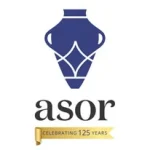
The Joys of Thinking on Your Feet
Dominique Langis-Barsetti, 2024 Katherine Barton Platt Fieldwork Scholarship
For many, archaeology is either an epic tale of breathtaking ruins, jaw-dropping finds, and exciting adventures in faraway lands, or a story of trowels, brushes, and dirt, and the delicate fragments of the past they reveal. For students coming to the field for the first time or joining a new project, the awe and wonderment associated with those visions of archaeology are very well in the cards. For those of us helping to run those projects and involved in making the archaeology happen, a field season is more often than not an exercise on thinking on your feet and embracing the chaos. A chaos that you must somehow harness, tame, control, and put to good use. This is all the more true when you work at one of the largest archaeological sites in Türkiye (fig.1), on a topographically-complex mountaintop, with a large team of local and international collaborators. But without the challenges, archaeology would not be nearly as much fun.

The 2024 season of the Kerkenes Project started with an eight-week delay, as we arrived in the field in mid-June. Despite this setback, we were determined to make as much of our time abroad as we could, both for the sake of our research agenda and for the field school students who had accompanied us. As the ground of our ancient 271-hectare city was now dry and sunbaked, we had to (mostly) put aside the extensive program of electrical resistance we usually carry out every year and jump straight into excavations.
The original plan for the season involved dismantling a section of an unstable wall. Despite our best efforts to preserve it, the western wall of one of the city’s large columned halls had been crumbling away since it had first been exposed a decade ago. Unlike most walls at Kerkenes, which are composed of large facing stones holding in a core of rubble fill, this wall was part of a large room that had been built without facing stones. Originally, the stabilizing role of the missing facing stones had likely been fulfilled by wooden planks used a cladding, but with the wood now entirely gone, the rubble core was spilling out. The goal of the season’s excavations was thus to remove the rubble core down to the wall’s foundations (fig. 2). Documenting any evidence of construction techniques encountered in the process was a priority, particularly the placement and arrangement of wooden beams and posts incorporated into the structure. A small section of the same wall taken apart nearly a decade ago suggested that we might find the remains of large wooden posts at somewhat regular intervals within the fill. We were pleasantly surprised to discover that the wall’s structure was in fact much more complex. Since a portion of my doctoral research focuses on Iron Age construction techniques at the site, I was grinning much more widely than the students who had to spend several sweltering summer days carefully articulating the carbonized wooden remains. In the end, we discovered a series of half-round tie beams placed within the foundations of the wall, with pairs of posts placed atop them. Unfortunately, most of the wood had been reduced to ash by the devastating fire that destroyed the city over 2500 years ago, but some carbonized fragments are just large enough to let us hope for dendrochronological dates.
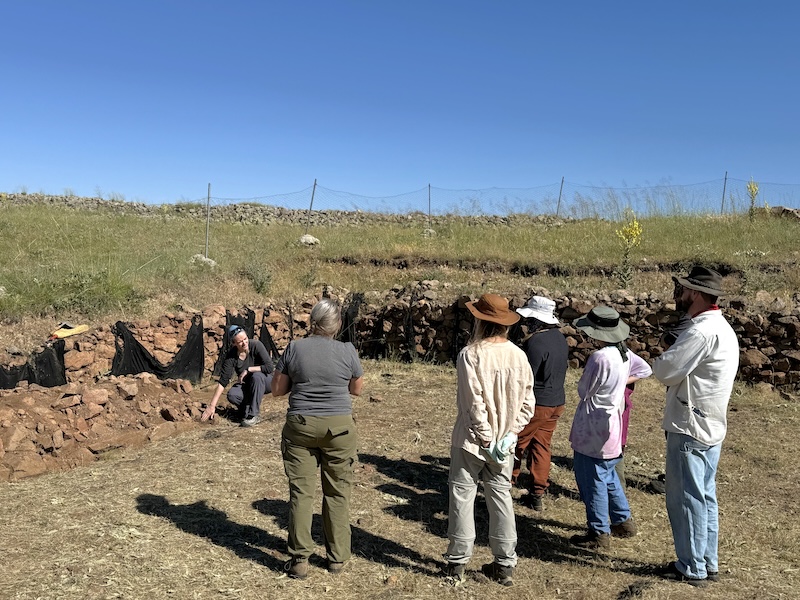
Amid one of the hottest summers on record, weeks after rains had stopped softening the soil of the central Anatolian plateau, we therefore had to come up with a plan to survey at least one 20 m by 20 m grid using electrical resistance. Although curtailed, the geophysical survey season could not be entirely cancelled since it represented an integral part of the field school. While in Türkiye, students learn about geophysical surveying, gain firsthand excavation experience, spend time with a variety of archaeological specialists, and are immersed in the life of a small central Anatolian village. With a much-shortened 2024 season, we had to come up with ways to make sure our students would still get the opportunity to learn the skills they had travelled halfway across the world to explore. This led to a rather intensive program, where lectures taking place during some of our off time replaced some of the hands-on experience that could not be accommodated. Despite the less-than-optimal conditions, students still spent two days learning geophysical survey techniques. After an intensive round of lectures, they gained practical experience through a survey of the excavation compound’s yard. In doing so, they learned about surveying in different environmental conditions, how to adapt to non-ideal ones, and what happens when equipment breaks. But surveying a small grid sandwiched between a dorm, a tractor, and a garden can only teach you so much. As the geophysical instructor, it was up to me to find a portion of the site where electrical resistance could still be carried out. We were now more than a month after the typical end of the geophysics season, at a time of the year when most of the clay-rich ground of the site is barely softer than the granite bedrock. Under those conditions, the logical solution was to survey a portion of the site that is normally too wet for electrical resistance. This meant driving around the site following the path of the ancient city’s water management system until I found a patch large enough and moist enough for a proper survey. In the spring, the different streams and reservoirs are usually too full of water to be surveyed. As we were now nearing the height of summer, much of those had dried up, revealing ground we usually could not access. To their credit, the students got through an entire grid by themselves, quickly learning the main aspects and challenges of geophysics as we collected new – and useable! – data (fig. 3).
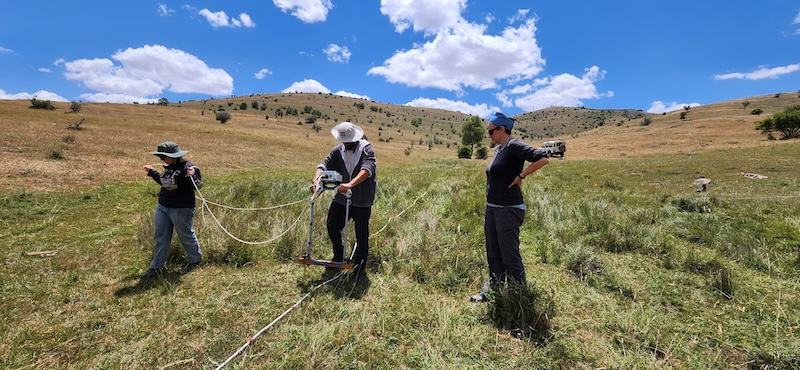
To make up for the absence of some of our specialists, the senior staff present in the field shared some of their own skills with the students in small workshops that do not normally take place. As the peculiarities of this season’s excavation plan meant very little osteological material was recovered, the students instead participated in the exhumation and preparation of new additions to our animal reference collection. Under the guidance of a specialist post-doctoral student, they excavated and cleaned modern remains, probably learning more than they wanted about cow and turtle anatomy and the decomposition process (fig. 4). To replace weeks and weeks of repetitive trench recording, the students were initiated to photogrammetry by making their own 3D model of a rubber duck and recorded artefacts with our handheld structured light scanner. They got a taste of the cutting-edge tendencies at Kerkenes when robots came for a test drive at the site, and everyone got to try the latest version of the DATCH heritage recording application for the HoloLens 2 mixed-reality headset (fig. 5).
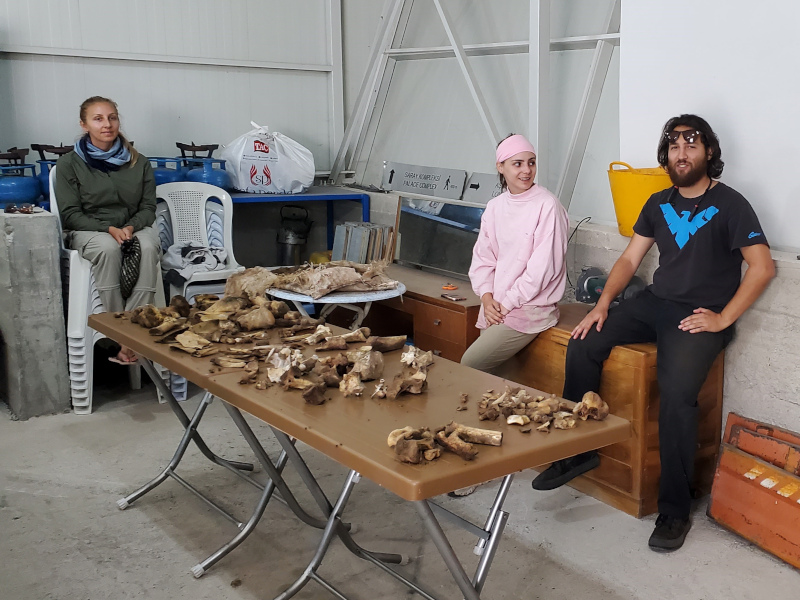
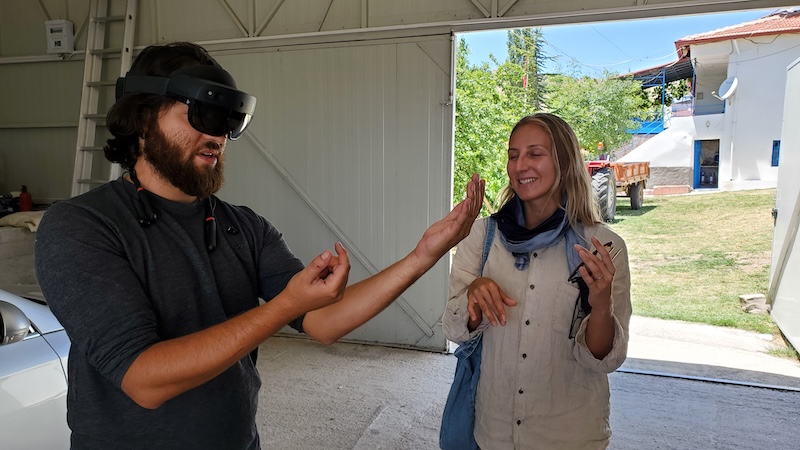
In addition to teaching activities within the team, the Kerkenes Project also partakes in several educational and outreach activities every year, teaching the local community and visitors to the site about the archaeology of Kerkenes. Less time in the field meant fewer chances to carry out those activities, so we got creative. Literally. In conjunction with the team from Uşaklı Höyük—a mounded site located 7 km from Kerkenes—we visited a women cooperative in the nearby town of Sorgun that paints ceramic vessels according to different decorative traditions. Archaeologists and ceramicists discussed ornamental techniques and motifs, comparing ancient and modern approaches. We introduced the participating cooperative members to decorative styles common in the region during the Iron Age, and they in return shared their knowledge of pigments and painting methods. We hope this leads to a revival and reinterpretation of ancient local motifs in the future (fig. 6).
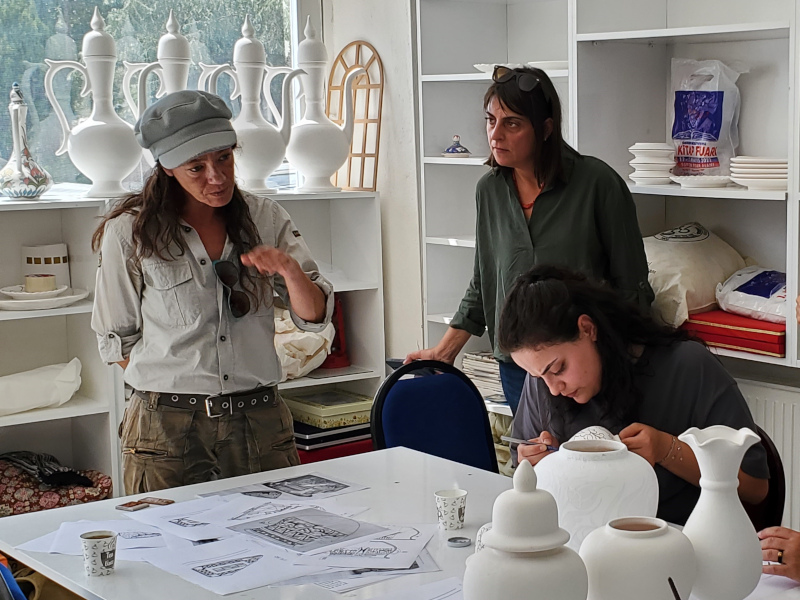
Another of Sorgun’s women-led cooperatives specializes in the crafting of glass beads and figurines. One of the artists at the heart of this initiative visited the Kerkenes dig house and shared with us their process, their techniques, the materials they use, and the crafting challenges they face. We participated in the discussion by sharing images of ancient beads recovered at the site and elsewhere in the area, discussed local glass traditions going back millennia, and offered to provide them with all our empty glass bottles next season, to be melted down and remade into recycled glass beads. The enthusiasm from all participants was energizing and we hope this discussion leads to further collaborations and a melding of local crafts and archaeology.
Arriving so late in the field also meant we had a few surprise visitors. Among them was a group of professional painters and mosaicists on a week-long stay in the region. The goal of their artistic sojourn was for them to each produce two new artworks inspired by the area. We only caught them at the end of their stay, but they kindly invited us to their pop-up exhibit. Further discussion during the event led to a preliminary artistic plan for next year. We hope this collaboration comes to fruition, especially since we strive to include more local interpretations and impressions of the site into the narrative surrounding Kerkenes, which is currently mostly focused on the archaeology.
Overall, the 2024 Kerkenes field season was a success, despite the many challenges we faced. As an associate director on the project, many of those challenges land squarely on my desk, often with very little notice. Solving them usually comes down to a happy marriage of archaeological knowledge, logistical creativity, out-of-the-box thinking, and an open mind. And just a touch of crazy. For flavour. Some days this means driving the steep slopes of the sites for an “adventure” with students who did not get to spend as much time exploring those slopes themselves while also being on the lookout for that darker green hue indicative of retained moisture and softer soil. Sometimes it means making make-shift lanterns so the team can have some fun playing boardgames while the storm that knocked out our power blows past. And sometimes it means converting excavation equipment into firefighting gear when the dead tree next door catches fire in the middle of the night. We do archaeology for a chance to learn about the past, solve ancient mysteries – however mundane – and explore the unknown, so we have to be ready – and willing – when the unknown finds us.
Dominique Langis-Barsetti is a doctoral graduate from the University of Toronto and a member of the Kerkenes Project since 2010. On top of her duties as Associate Director, she teaches geophysical surveying, photogrammetry, excavation techniques, and archaeological illustration to students on the Project.
Latest Posts from @ASORResearch
Stay updated with the latest insights, photos, and news by following us on Instagram!
American Society of Overseas Research
The James F. Strange Center
209 Commerce Street
Alexandria, VA 22314
E-mail: info@asor.org
© 2025 ASOR
All rights reserved.
Images licensed under a Creative Commons Attribution-NonCommercial-ShareAlike 4.0 International License

